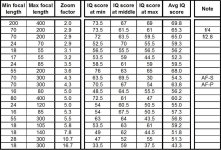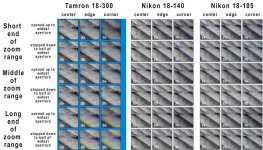In another thread discussing the Nikkor 18-140, I voiced my opinion that its wide zoom range meant that the image quality had to be fairly poor. I sometimes like to test my opinions against hard data, so I went back to do a little bit of analysis. Thought the results might be interesting for some of you, too:
In all of their lens tests, the folks at German photo mag ColorFoto use identical setups and publish detailed data on their findings. The below table summarizes their IQ scores for all of Nikon’s standard and tele zooms the magazine tested on DX, all on a D7100, always the latest version of the respective lens unless otherwise noted. They test zoom lenses at both ends plus at the mid point, awarding an IQ score for each of them. That IQ scores reflects an overall assessment of all optical characteristics, not just sharpness, by the way.
I sorted the table by zoom factor to determine whether there is a correlation with average IQ. Just FYI, I looked at FX as well, where the trends are similar but the results are less conclusive because of the lower number of lenses tested.

We all know that at least for some lenses, copy-to-copy IQ seems to vary quite a bit, so it is very possible that the magazine had a particularly good or bad sample for one test or another. The general trend nevertheless remains pretty clear. You are welcome to draw -and share- your own conclusions. Here are mine:
Hope this is helpful. Interested in your take.
In all of their lens tests, the folks at German photo mag ColorFoto use identical setups and publish detailed data on their findings. The below table summarizes their IQ scores for all of Nikon’s standard and tele zooms the magazine tested on DX, all on a D7100, always the latest version of the respective lens unless otherwise noted. They test zoom lenses at both ends plus at the mid point, awarding an IQ score for each of them. That IQ scores reflects an overall assessment of all optical characteristics, not just sharpness, by the way.
I sorted the table by zoom factor to determine whether there is a correlation with average IQ. Just FYI, I looked at FX as well, where the trends are similar but the results are less conclusive because of the lower number of lenses tested.

We all know that at least for some lenses, copy-to-copy IQ seems to vary quite a bit, so it is very possible that the magazine had a particularly good or bad sample for one test or another. The general trend nevertheless remains pretty clear. You are welcome to draw -and share- your own conclusions. Here are mine:
- While many other factors play a role, there is a clear correlation between zoom range and image quality. Top IQ scores on the list are found mostly near the narrowest zoom ranges, while the widest zooms usually earned bottom IQ scores. There are notable exceptions, but those are exceptions, not the rule.
For extreme zoom factors, say, greater than 5, it is very difficult or simply impossible to achieve good optical performance. With the exception of the 18-105, which performs relatively well, all of these lenses rank near the bottom of the list if you sort it by IQ.
. - Tele zooms usually have poorer IQ at the long end. Particularly bad examples are the 55-300, 70-300, and 80-400. However, this does not always have to be the case, as the 55-200 and 28-300 show.
Hope this is helpful. Interested in your take.
Last edited:





